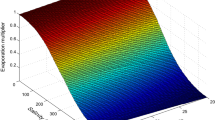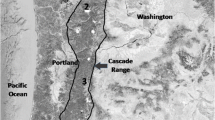Abstract
Internal alkalinity generation is modeled by an input-output approach in which equations to describe budgets for sulfate, nitrate, ammonium, and base cations are linked to an alkalinity budget equation. Calibration of the sulfate model using ion budgets for 14 softwater lakes shows that the sulfate sink coefficient is reasonably uniform (mean = 0.46 m yr−1) and can be used to predict sulfate retention. Model predictions show that internal sulfate sinks are needed to correctly predict lakewater [SO4 2−] and that in-lake sulfate sinks can account for over 50% of input. For experimentally acidified Little Rock Lake, Wisconsin, the sulfate model predicts 90% recovery of [SO4 2−] 13 years after acid additions stop.
Similar content being viewed by others
References
Baker, L. A., Pollman, C. D., and Brezonik, P. L. : 1985, ‘Development of Interpretive Models for Lake Acidification in Florida’, inFlorida Acid Deposition Study, Phase IV, Environmental Sciences and Engineering, Inc., ESE 83-152-0602-0120.
Baker, L. A., and Brezonik, P. L.: 1986, ‘Model of Internal Alkalinity Generation for Softwater Lakes’, in preparation.
Baker, L. A., and Brezonik, P. L., and Edgerton, E. S.: 1986,Water Resources Research 22, 175.
Brezonik, P.L., Baker, L., Eaton, J., Frost, T., Garrison, P., Kratz, T. Magnuson, J., Perry, J., Perry, T., Rose, W., Swenson, W., Watras, C., and Webster, K.: 1986,Water. Air, Soil Pollut., in review.
Cook, R. B., Kelly, C. A.; Schindler, D. W., and Turner, M. A.: 1986,Limnol. Oceanogr. 31, 134.
Dillon, P. J: 1986, personal communication.
Hultberg, H.: 1985,Ecological Bulletin (Stockholm) 37, 133.
Mitchell, M.J., David M.B., and Uutala, A.J.: 1985,Hydrobiologica 121, 121.
Perry, T. E., Baker, L. A., and Brezonik, P. L.: 1986,‘Comparison of Sulfate Reduction in Microcosms, Mesocosms, andin situ at Little Rock Lake’,Proc. Seventh N. Am. Lake Mgmt. Soc. Meeting, in press.
Schindler, D. W., Rudd, J. W. M, Kelly, C. A., and Turner, M. A.: 1986a,Water, Air, Soil Pollut., in review.
Schindler, D. W., Turner, M. A., Stainton, M. P., and Linsey, G. A.: 1986b,Science 232, 844.
Schnoor, J. L.: 1985,‘cidification of Aquatic and Terrestial Systems’ in Stumm, W. and Schnoor, J. L. (eds.),Chemical Processes in Lakes, John Wiley and Sons, 311.
Schnoor, J. L.: 1986, personal communication.
Vollenweider, R. A.: 1975,Scheiz. Z. Hydrol. 37, 53.
Wentz, D. A., Garrison, P. J., and Bockheim, J. G.: 1986. ‘Chemical input-output budgets for Round and East Eight Mile lakes’, report to Electric Power Research Institute.
Wright, R.F.: 1983,Hydrobiologica 101, 1.
Author information
Authors and Affiliations
Rights and permissions
About this article
Cite this article
Baker, L.A., Brezonik, P.L. & Pollman, C.D. Model of internal alkalinity generation: Sulfate retention component. Water Air Soil Pollut 31, 89–94 (1986). https://doi.org/10.1007/BF00630822
Issue Date:
DOI: https://doi.org/10.1007/BF00630822




